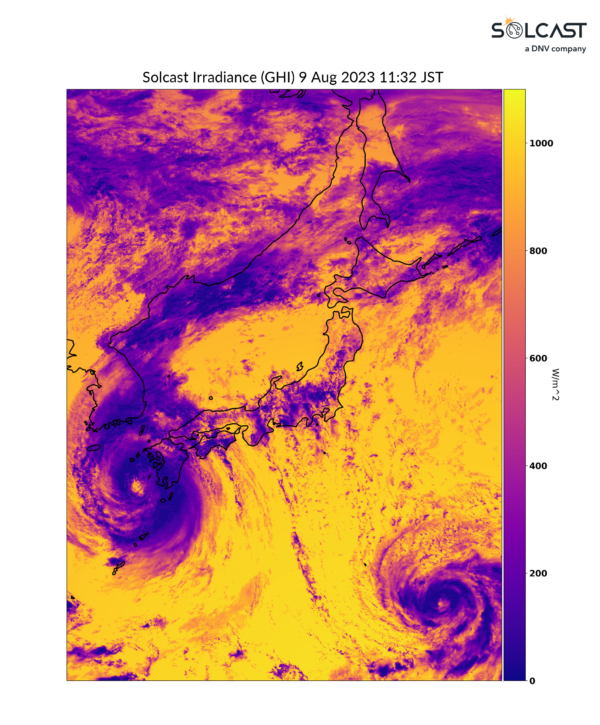El Niño and a weaker Indian monsoon boosted solar production across large parts of Asia during August, punctuated by clouds from seven Typhoons, according to data collected by Solcast, a DNV company, via the Solcast API.
India and Southeast Asia saw above average August irradiance due to the developing 2023 El Niño event. In India, El Niño acts to weaken the Indian Summer Monsoon, while over the Philippines, Indonesia, Thailand and Vietnam, El Niño acts to suppress cloud events.

Southern India was the standout in terms of unusual irradiance, with 40% more than the August average. This brought the average irradiance up to 6 kWh per day. This is normally a time of lower irradiance due to cloudy conditions during the Indian Summer Monsoon, but the monsoon has been weak this year, with anomalously low wind and rainfall. This is attributed to the developing El Niño event.
The benefits for solar production brought by the weak monsoon were outweighed by the loss of wind and hydroelectric power generation due to the same phenomenon. The overall deficit of renewable energy sources led India to increase its coal generation during August. At the same time, hotter days and the need for more irrigation pumping in dry conditions, increased power demand. According to Grid India data, there was record power usage of 243.9 GW on 31 August, which exceeded available capacity by 7.3 GW.
This underlines the benefit of good analysis and forecast information for renewable energy resources to enable the management of power networks in the face of weather-sensitive intermittency.
El Niño is generally associated with drier than average rainfall over southeast Asia. Consistent with this, Solcast’s analysis showed that solar production was above normal in Thailand, Cambodia, southern Vietnam, the Philippines, and Indonesia, with areas of solar irradiance up to 130% above the August average.
The cloud associated with typhoons can significantly reduce solar generation potential, besides the more direct impacts these events can have on power generation and distribution infrastructure. El Niño is typically associated with a shift of Western Pacific typhoon activity to the east away from Asia. Despite this, August saw several impactful typhoon events. Of the 7 typhoons for the month, 4 made landfall.

Image: Solcast
Over western Japan, Typhoons Khanun and Lan caused widespread cloudiness during 5-10 and 14-16 August, leading to overall irradiance for the month being down 10%. This contrasts with northern Honshu which was missed by the typhoons and experienced 30% more irradiance than usual for this time of year.
These weather systems brought over a dozen deaths, flooding and widespread damage in Japan. During Khanun, 160,000 households lost power, while Lan brought powerlines down and cut power to 100,000 homes.
Long-lived Khanun went on to traverse the Korean peninsula from south to north, which is a typhoon track that hasn’t been observed since records began in 1951. It brought flooding and landslides and left 40,350 people without electricity in South Korea.
Solcast produces these figures by tracking clouds and aerosols at 1-2km resolution globally, using satellite data and proprietary AI/ML algorithms. This data is used to drive irradiance models, enabling Solcast to calculate irradiance at high resolution, with typical bias of less than 2%, and also cloud-tracking forecasts. This data is used by more than 300 companies managing over 150GW of solar assets globally.
This content is protected by copyright and may not be reused. If you want to cooperate with us and would like to reuse some of our content, please contact: editors@pv-magazine.com.



By submitting this form you agree to pv magazine using your data for the purposes of publishing your comment.
Your personal data will only be disclosed or otherwise transmitted to third parties for the purposes of spam filtering or if this is necessary for technical maintenance of the website. Any other transfer to third parties will not take place unless this is justified on the basis of applicable data protection regulations or if pv magazine is legally obliged to do so.
You may revoke this consent at any time with effect for the future, in which case your personal data will be deleted immediately. Otherwise, your data will be deleted if pv magazine has processed your request or the purpose of data storage is fulfilled.
Further information on data privacy can be found in our Data Protection Policy.